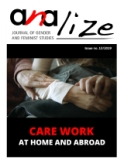Nannies that Care. An Emergent Socio-Professional Category between Legal Regulations and Working Arrangements
Nannies that Care. An Emergent Socio-Professional Category between Legal Regulations and Working Arrangements
Author(s): Ionela Băluță, Anca DohotariuSubject(s): Gender Studies, Education, Labor relations, Welfare systems, Present Times (2010 - today)
Published by: Societatea de Analize Feministe AnA
Keywords: nannies; childminding; paid childcare; informal care arrangements; Romania;
Summary/Abstract: Drawing on qualitative field research conducted in the Bucharest - Ilfov region in 2013, this article approaches nannies’ working arrangements, understood as either formal or informal paid activities carried out as part of the childcare process. First, we focus on the social, political, and legislative context in which nannies’ work emerged and developed. This analysis is necessary for a better understanding of the main factors that influence the current social values and practices regarding childcare in Romania (from our interviewees’ point of view, but also in close connection with the hegemonic cultural meanings regarding childcare, parenting, and mothering). Second, we examine nannies’ individual choices and professional trajectories as important indicators for the social dynamics of current care working arrangements and gender roles. Our aim was to identify, on the one hand, the reasons behind choosing formal or informal working arrangements and, on the other hand, nannies’ social practices, values, and cultural meanings related to (paid) childcare. We thus sought to understand the extent to which, in contemporary Romania, there is (or not) a real social need regarding the professionalisation of an occupation that can most often be identified and observed as informal work.
Journal: AnALize: Revista de studii feministe
- Issue Year: 2019
- Issue No: 13 (27)
- Page Range: 59-79
- Page Count: 21
- Language: English

